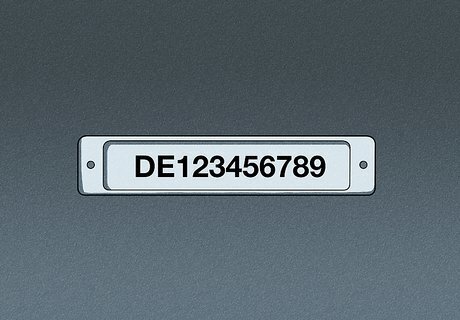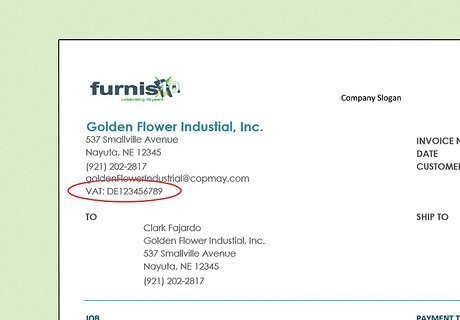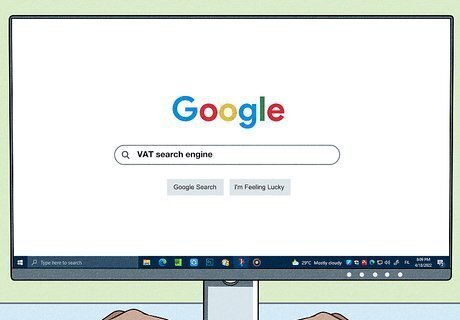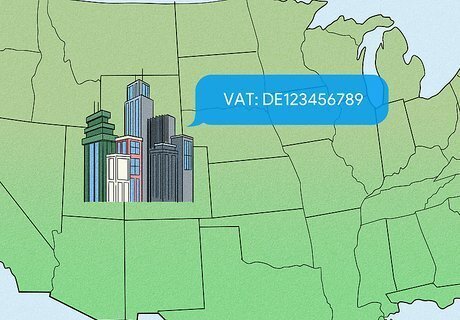
views
- Look at the company’s invoices, insurance forms, or tax documents for the VAT number. It will contain 2 letters and multiple digits.
- Try searching for the company on a VAT search engine to find their identification number.
- Contact the company directly and ask for their VAT number. You may need to submit a formal request to access the number.
- Validate the VAT number with an online VAT validation tool, or by calling the country’s business or tax department.
What is a VAT number?

A VAT number is a tax ID code containing 2 letters and multiple digits. The VAT country code at the beginning of the ID is always 2 letters, and corresponds with the letters in a country's name. The number of digits that come after the letters vary between countries, but they’re usually 8–12 numbers or letters. Each company has a unique VAT number, so no two will be the same. Example: VAT numbers for Germany start with the letters “DE” and are followed by 9 digits, such as DE123456789. Example: The VAT country code for Estonia is EE, so an Estonian business's VAT number may look like EE93810511 The letters at the start of a VAT number may change based on the language you’re using. For example, the French VAT code is FR in English, but TVA in French. Use the right VAT code based on the government document that is requesting the information. VAT is a type of tax that is charged incrementally by manufacturers based on the product’s value. The government uses VAT numbers to calculate charges and taxes across borders, as well as to determine prices for goods and services in the country where they’re being sold.
Locating a VAT Number

Look at an invoice or insurance document to find a VAT number. If a company uses VAT taxes in their prices, they’ll usually list the company’s VAT number somewhere on the document. Check for VAT numbers near the letterhead on top of the page or by the information at the bottom.

Look for the company on a VAT search engine. If you know the company’s full name and the location where they’re based, you may be able to do a reverse lookup for their VAT number. Enter the country code for the country where the business is registered. Then, enter the company's official name into the search bar to see if the VAT numbers are publicly listed. Most VAT number search engines are for companies based in the European Union (EU), but they may also show results for a few non-EU countries. If the company you're inquiring about isn't in the EU or UK, search the country’s name and the term “VAT registry.” You usually have to enter the official name listed on the business's registration. So if you search for “Microsoft” when you're looking for “Microsoft Indonesia,” you may not see any results. A company's official name may be slightly different from its main product. For example, Pepsi is actually the name of a product while PepsiCo, Inc is the company name. Sometimes the search engines retrieve an outdated or incorrect VAT number. Always cross-reference the VAT number to guarantee its authenticity.

Contact a company directly to get their VAT number. Look for the company’s contact information and reach out to their tax department. Ask them for the VAT number and let them know what you need it for. If they have their VAT number as public information, they’ll tell you what it is over the phone. You may need to file an official request document to solicit a company's VAT number if it’s not public information. Some companies have multiple headquarters for different countries. For example, Apple is located in the United States, but Apple Ireland is located in Ireland. For tax purposes, they're considered 2 different companies. Alan Schenk Alan Schenk, VAT Law Professor When searching for a business's VAT number, first check the company's website, invoices, tax documents, or VAT registration certificate. If still not found, search government databases like the EU's VAT Information Exchange System. As a last resort, directly contact the business's tax department.
How do you validate a VAT number?

Use an online VAT number validation tool. The online validation tool you use depends on the country where the company is based. Just type the company’s VAT number into the tool and submit it. The corresponding business will pop up, and you'll be able to verify that the number belongs to the right company. Use the VIES search engine to validate the VAT number for companies in the EU. For companies based in the United Kingdom, use the UK government site to see if the VAT number is valid and learn the name and address it's registered to. Companies outside of the EU and UK may have their own validation sites. Try searching online for the name of the country plus “VAT number validation” to find their sites.

Call the British VAT hotline for help looking up a number in the UK. Her Majesty's Revenue and Customs (HRMC) is a government agency that regulates and monitors international business in the United Kingdom. If you’re located in the UK, dial 0300-200-3701. If you’re trying to contact the hotline outside of the UK, then dial +44-2920-5011-261. Tell the representative the VAT number and they’ll let you know if it’s valid or registered to anyone. The HMRC helpline is only available during the week from 8 am to 6 pm BST.

Contact a country's customs agency or business bureau. Any country using VAT will have a list of registered companies and their identification numbers. Look up the name of the country plus “customs agency” or “business bureau” to find the official government site. Contact the government agencies either over the phone or by email to ask them about the VAT number you found for a company. They’ll be able to help you find the correct information.
Do all companies have VAT numbers?

Companies selling to countries with VAT have ID numbers. If any goods or services cross the border into a country that uses VAT, then that business is required to register for a VAT number. That way, the government can determine the amount of taxes they need to charge. A total of 170 countries and territories use VAT. The U.S. doesn’t use VAT since companies charge sales tax at a state level. VAT isn’t charged for financial services, education, property, or charity events.



















Comments
0 comment